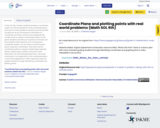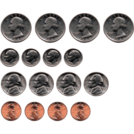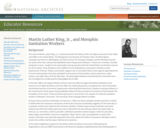
6.8 Coordinate Plane Co-Teaching MIP
- Subject:
- Mathematics
- Special Education
- Material Type:
- Lesson Plan
- Provider:
- VDOE
- Author:
- VDOE
- Date Added:
- 10/07/2024

6.8 Coordinate Plane Co-Teaching MIP

In this 40-day module, students develop a coordinate system for the first quadrant of the coordinate plane and use it to solve problems. Students use the familiar number line as an introduction to the idea of a coordinate, and they construct two perpendicular number lines to create a coordinate system on the plane. Students see that just as points on the line can be located by their distance from 0, the plane's coordinate system can be used to locate and plot points using two coordinates. They then use the coordinate system to explore relationships between points, ordered pairs, patterns, lines and, more abstractly, the rules that generate them. This study culminates in an exploration of the coordinate plane in real world applications. VDOE supported resource guides students through identifying coordinates and plotting points.

Cotton Candy Poem Analysis (figurative language and poetic structure)

TSW learn how to argue a position and introduce a counterclaim. As most of our writing for Grade 8 is persuasive or expository, this is a good assignment for any week within the first semester (Q1 or Q2). This will follow the same outline of writing as their 42 SOL prompts. The question is “should information be restricted in all areas by the government or in only certain areas?”

The purpose of this podcast is for students to listen and participate in counting backwards from 30 to 1. Students will be able to orally count by ones backwards while following moving to different speeds.

In this lesson, students will practice orally counting to 100 and gain number sense to be able to sequence numbers correctly.

Determine the value of a collection of like coins whose total is 100 cents or lessMathematics Instructional Plans (MIPs) help teachers align instruction with the 2016 Mathematics Standards of Learning (SOL) by providing examples of how the knowledge, skills and processes found in the SOL and curriculum framework can be presented to students in the classroom.

1.1cd Counting Co-Teaching MIP

With this lesson, students will practice the Math Standards of Learning around counting and comparing values of money and creating equations while also learning computer science terminology for problem solving. Students will learn to start counting change with the highest value coin possible.

Place Value, Composing and Decomposing NumbersMathematics Instructional Plans (MIPs) help teachers align instruction with the 2016 Mathematics Standards of Learning (SOL) by providing examples of how the knowledge, skills and processes found in the SOL and curriculum framework can be presented to students in the classroom.

Counting and writing numerals from 0 to 110Mathematics Instructional Plans (MIPs) help teachers align instruction with the 2016 Mathematics Standards of Learning (SOL) by providing examples of how the knowledge, skills and processes found in the SOL and curriculum framework can be presented to students in the classroom.

CD3.1 MathematicsComparing numbers, counting, and recognizing quantities

This lesson provides fliers and other documents related to the demonstration in Memphis on March 28, 1968. On that day, students near the end of the march broke windows of businesses. Looting ensued. The march was halted. King was deeply distressed by the violence. He and fellow leaders negotiated a commitment to nonviolence among disagreeing factions in Memphis, and another march was planned for April 8. On April 4, as he stepped out of his motel room to go to dinner, he was assassinated.

This resource provides a 5E style lesson (Engage, Explore, Explain, Elaborate, Evaluate) over the rock cycle, including a single-period lab using crayons to model the cycle. It’s often a difficult concept for students to imagine that over millions of years, one kind of rock will change into another kind of rock. This lab allows students to see the changes taking place, and learn important qualities of each type of rock and how they are formed.Photo: Rainbow of Crayon Shavings by Richie Girardin via Flickr

An integrated Mathematics and computer science lesson to rEnglishte multistep practical problem rEnglishtionships to algorithms & programming.

In this unplugged lesson, students will deepen their understanding of algorithms and the need for precise, sequenced instructions. They will create algorithms for drawing crazy characters. Then, they will test and refine these algorithms by challenging teammates to follow their instructions and compare. They will also use cause and effect in this lesson.

At the beginning of the lesson, students will have the opportunity for physical movement during the activator while reviewing the difference between the terms “past” and “present”. Students will engage in collaborative conversations at multiple times to explore the different ways people communicated in the past and how it has changed over time, while also learning from their peers during these conversations. Through these collaborative conversations, students will gain an understanding on how computer scientists communicate information in various ways. Students will explore a nonfiction text during a read aloud to gain a stronger understanding of communication in the past before they embark on an independent activity of drawing and labeling past and present communication tools.

Students will investigate theoretical versus experimental probability by creating a model to simulate a system and then compare the outcomes.

Students will work in groups to plan the process they will use to first determine the perimeter and then the area of a rectangle. Students will write out a detailed step by step process that can be used in different situations.

Students create a class alphabet book or "ABCDarium," a book that uses images of animals or objects to illustrate each letter of the alphabet. The book is in the style of a medieval illuminated manuscript and incorporates both art and writing. Students decorate large uppercase letters of the alphabet and draw an original picture to illustrate each letter.